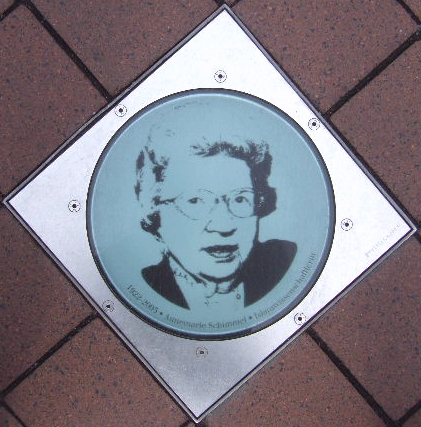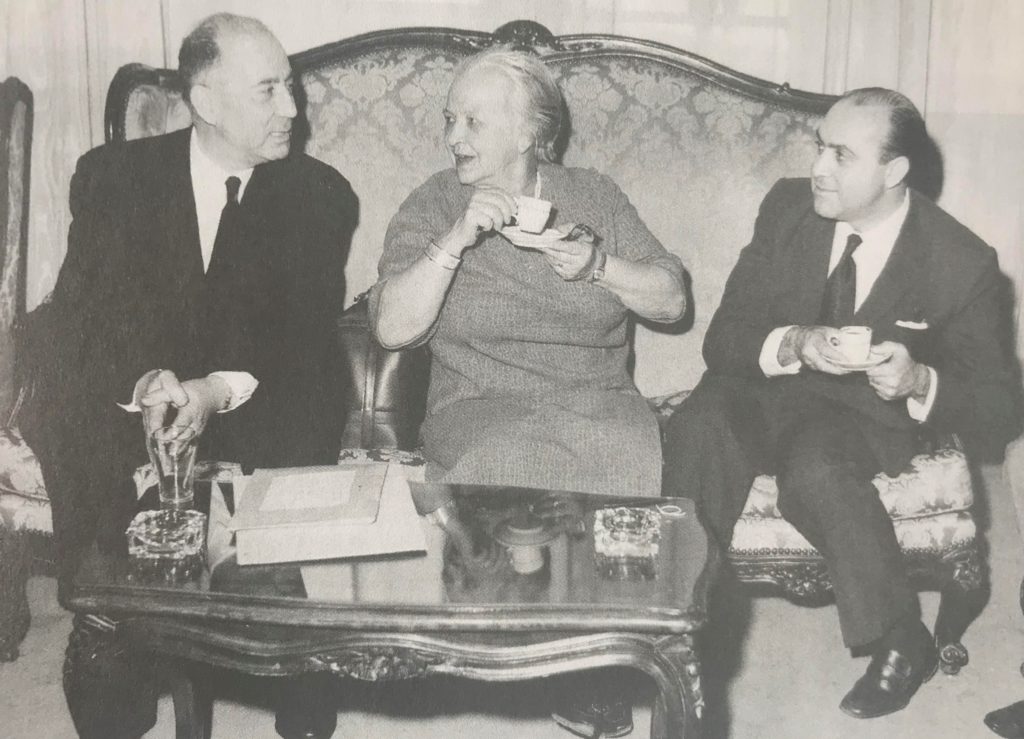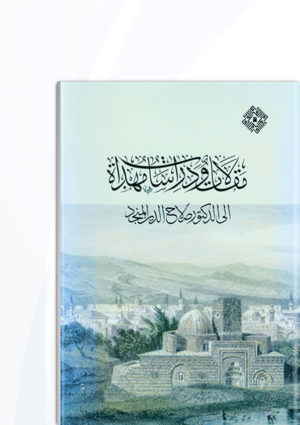Annemarie Schimmel

What to bring for a festive occasion? No doubt, flowers would be the right gift- but as we are far away from the scholar who is to be honoured we have to pluck some modest flowers from the gardens of literature, from poetry and prose, from Sufism and history. By doing so we remember the lovely story of a Turkish Sufi master of the 16th century who sent out
his disciples to gather flowers to decorate the khānqāh. Everyone returned with beautiful bouquets; one dervish, returned carrying only a little withered flower. When he was blamed for his gift that seemed not worthy of the occasion, he replied: ʻAll the flowers in the garden were engaged in recollecting their Lord and Creator, and I did not want to disturb their dhikr. This one, however, had just finished its dhikr, and so I brought it.ʼ It was this dervish who was appointed successor to the master for he knew that everything created is constantly remembering the Lord and praising Him, as the Qurʾān states.
The Qurʾān describes paradise as a wonderful garden. Yet, there is no description of particular flowers although the reader finds mention of fruit trees and cool shade. Descriptions of real gardens, however, develop only somewhat later, mainly under the influence of Persian traditions.
In the Abbasid period the development of urban culture led to a growing interest in gardens and flowers. At this historians begin to describe the wonderful gardens of Baghdad and Samarra where the caliph al-Mutawakkil used to indulge in his eccentric love of roses. Superb gardens are a hallmark of early Islamic civilisation, be it in Cairo where the Tulunid Khumarawaih laid out gardens with a multitude flowers and trees, or in al-Andalus where the last gardens built under Muslim rule are still extant, though in altered from. In the East, the Timurids followed the example of their ancestor Tamerlane whose gardens- large enough to accommodate numerous tends- inspired his successors in eastern Iran and even more to create gardens wherever they went. Babur, the first ruler of the house of the great Mughals in India (d.937/1530) dramatically describes his activities to embellish the ʻugly landscapeʼ of Hindustan with gardens, and Mughal miniatures show in detail how the gardens were laid out. Babur's descendants, in particular the ladies of the Mughal house, founded numerous gardens in Agra, Delhi, Lahore and in Kashmir.

The Ottomans too were rightly famed for their love of flowers, especially of tulips, and tulips became the most precious export article from Turkey to western Europe, especially to the Netherlands, in the late 17th century. Ottoman artists used flower motifs, and among them mainly tulips, on textiles and ceramics- the Rustem Pasha mosque in Istanbul shows dozens of different kinds of tulips on its colourful tiles, and my Turkish friends told me that the tulip lālā لاله is dear to their hearts because its name consists of the same letters as the symbol of Islam, al-hilāl هلال, the crescent moon, and even more importantly, as the name of Allah الله.
Islamic gardens used to contain a reservoir or a tank, a smaller or larger lake, which formed its centre and reminded the poets of the heavenly salsabīl. Small water courses led to the basin- watercourses with rows of cypresses along their borders. The poets felt that the slender trees looked like elegant young ladies whose beauty was reflected in the water as though they were brides whose faces were seen by the bridegroom for the first time in a mirror…
Real gardens play a remarkable role in the works of Arabic and Persian historiographers. One may think of Ibn Iyās (d. after 928/1521) who describes in detail the garden which the last Mamluk ruler, Qanṣauh al-Ghūrī (d.923/1516) had laid out near the Hippodrome in the citadel of Cairo, a place where the indulged in listening to the numerous birdsʼ songs (birds where an integral part of royal gardens) and enjoyed the fragrance of Syrian roses which he had imported along with other flowers unknown in Egypt.
Fragrance was an important aspect of the gardens, and in a slightly later period royal gardens in southern India, in the kingdoms of Golconda and Bijapur, where often arranged in such a way that at daytime the visitor could enjoy the carefully chosen colours while he would be ravished at night by the fragrance of nocturnal flowers and herbs. This becomes evident from poetical descriptions in the epics of Deccani poets of the late 16th and 17th centuries.
Poets of the early Abbasid period enjoyed the rulersʼ increasing interest in gardens and with the development of the badīʿ style in Arabic poetry descriptions of flowers and gardens proliferate. Each flower represents some similarities with human beings, the uqḥuwān smiles with white teeth and the jasmine puts on pearl neclaces to participate in festive gatherings where rose-cheeked beauties enjoy themselves while the narcissi look at them with languid eyes. The long-awaited rains may write beautiful lines of coloured flowers on the ground while the dewdrops look pearl buttons on the red chemise of the anemone (or, in Persian, of the tulip). Or else the spring rains weave a coloured striped Yemeni gown for the earth, while winter covers the ground and the trees with a white woollen burnous or with ermine fur.
Garden imagery as it developed in the 9th and 10th centuries AD in Baghdad and at the Hamdanid court of Aleppo was immediately taken over by the Persian poets who had just begun to use their language for literary purposes. It was in Iran and the countries under her cultural influence that garden poetry developed most beautifully. Flower imagery is abundant not only in love poetry but in panegyrics as well, for the role of gardens and flowers could be alluded to in the tashbīb of a qasida as well: did not spring arrive in such glory because the prince who is to be praised has just completed a new garden with a pavilion so the ʻKing Springʼ has a worthy place to stay? As Farrukhi (d. 4289/1037 in Ghazna) claims. And was not the beloved a beautiful flower garden, ʻgarden of delightʼ? Her/his cheeks were never-withering roses, her/his eyes narcissi, her/his stature a walking cypress planted close to the lover's tearful eyes as though it was standing close to a brooklet? The dark curls reminded the poets of the fragrant musk-coloured hyacinths, and if the beloved was a young boy the violet might be the first down appearing on his face, or else, the poor modest violet might be an ascetic bent on his dark green prayer rug…
There is no end to such verses in Islamic literature. Thousands of nightingales, (bulbuls), complain in the verses of Persian and Turkish poetry of their unrequited love of the rose, (gul), which cannot be embraced as the watchmen, the thorns, surround it, and which is also faithless, for its life lasts only a few days…
But speaking of the different flowers the poets often pointed to their medical propensities- was not rose oil good for headaches? And should a melancholy person not be cured by applying violet oil?
A flower's shape, fragrance, and colour might point to special metaphorical aspects of its ʻpersonalityʼ: the rose- the hundred -petalled centifolia- could be a book with a hundred pages out of which the nightingale reads his love-songs; the red-faced tulip with a black spot in its heart might appear as a black-hearted hypocritical person or, else, as a suffering martyr with a blood stained coat; the weeping willow wrings its hands in despair when looking at people's misery, and the arghuwān with its red flowers may represent drops of blood, and so, all of nature turns into a representative of the human condition.
On a completely different level are the numerous books and treatises about gardening and agriculture, which can be found from early times onward in classical Arabic literature and continued into the modern ages where examples are known from India as well as from Turkey; treatises about the layout of gardens with illustrations do not lack either.
One Arabic book on flowers that attracted the interest of European scholars as early as beginning of 19th century, was Ibn Ghānim al-Maqdisī's (d.673/1274) work: Kashf al-Asrār ʿan Ḥikam al-Ṭuyūr wa al-Azhār. It was edited as early as 1821 by Silvestre de Sacy under the title, Les oiseaux et les fleurs, and translated into German in (d.1267/1850) by a little-known translator called Peiper and Published in Hirschberg (Silesia). Other editions and translations followed.
As the title indicates, the book has a strong mystical leaning. The author talks to the spring breeze and the flowers of the garden, and everything tells him its wishes and hopes. But not only flowers and trees talk to the author but also the birds. Thus Ibn Ghānim offers an introduction into the mystical aspects of the garden- ideas that were found to a certain extent also in the works of Ibn Ghānim's great contemporary, Mawlānā Jalāladdīn Rūmī in Konya who, it seems, also understood the language of everything created and translated it into sweet Persian verse.
Ibn Ghānim's work has been known in both east and west for a long time. But there is another treatise which is still in manuscript although it seems to be one of the strangest compilations in the field of what we may call ʻthe secrets of flowersʼ. My colleague, Gregor Schoeler, has described it in his catalogue of the Arabic manuscripts in the Berlin Staatsbibliothek, and I owe to his encouragement the wish to study it more intensely in the hope of editing it, in the future.
The manuscript has the number Or. Oct. 1324, Sammlung Hartmann, (d.1330/1912) and contains 54 folios with 9 lines; it is written in a rather large, pleasant hand in naskh. The author is not known. The title says:
ديوان شاه زمان سلطان مصطفى خان يشتمل على نثر درّي ونظم ملكي جوهري
This, however, is wrong as the unknown author dedicates his booklet to Sultan Selim Yavuz (d.1520 AD) as becomes clear from his extended praise of the ruler where he expresses his hope that the work may find acceptance at the court and bring some reward, for he lives, as he claims, in utter poverty and destitution. The text is arranged in nine lines; unusually, some sentences in highly complicated rhymed prose alternate with poems, generally of four lines, that take up the ideas of the prose section; once in a while a riddle is inserted. The author must have been an excellent scholar of Arabic as he plays with the language as did the poets in earlier, times, and he was, no doubt, a Sufi as we can understand from his vocabulary that abounds in expressions used by Sufi writers when describing the glory of the prophet Muhammad. But, unfortunately, nothing points to his identity.
After the basmala the text begins with the words:
نحمد الله على ما أدرج في دررٍ منشورة زمرّدية الأمواج وأخرج عن زُهَرٍ منشورة مشارًا زبرجديَّة الأفواج...
Followed by the first of the numerous little verses of the author's style. His description of nature led to the conclusion that God:
... ورتب من مناظرها مرائي
شهودٍ لرؤية جمال أنبيائه
This leads to the author's praise of Sultan Selim and his request for some favour:
فالغرض من نظم هذه الدرر ورسم هذه الغُرر أنّ السلطان الأعظم والخاقان الأكرم، سابق ميدان العدالة، فائق ديوان الجلالة درّة معارج الإقبال غرة برج الإفضال إكليل مفارق الأكوان قنديل مشارق الأعيان...
On fol. 8b, the author explains his work which consists of two parts, one devoted to the winter, the second one to spring
فصل الشتاء، مشتمل على لطائف الحمد والثناء وشرائف المجد والبهاء مرسومٌ بدرّة العبر في ألطاف موجد البشر، والأصل الثاني في فصل الربيعية متكفلٌ للصّفات الشفيعية والنكات الديعية مرسوم بروضة الزهر في أوصاف سيد البشر...
In the description of winter, which starts on fol. 9b, the reader finds skilful allusions to the letters of the alphabet (fol. 11 a sequ.) which contain interesting points and seem to show that our author was well acquainted (as most of his colleagues were) with Ibn ʿArabī's terminology: Are we not ʻletters in the heightsʼحروف عاليات (fol. 13 b)? On fol. 15 the part on the wintry season is finished, and the author praises God who sent the Isrāfīl of the spring breeze to revive the dead nature (a Qurʿānic phrase that is commonplace in poetry and was often used by Mawlānā Rūmī)
وسبحان من قلّب الشتاء ربيعًا وإليه تُرجع الأمور جميعًا أمر لإسرافيل الهواء أن ينفخ في صور النشو والنماء لإحياء تلك الأجزاء ما كانت هباءً منبثًّا.
And thus, everything appears in new glory:
طواويسُ تُنشَئ في بطون الحواصل
فراديس تنشو من عيون البلابل
فسبّح بحمد الله واشكره إنه
جوادٌ كريم ذو هباتٍ جزائلٍ
As with every poet, our author also dwells in particular on the peculiarities of the rose (fol.24a sequ.) Is not the rose embellished by the Light of the Prophet? And we find also the comparison of the rose with Jesus- a comparison that is as old as Persian poetry. For shortly before the year (d.390/1000) the Persian poet Kisāʾī invented the beautiful idea that the branch is like the Virgin Mary which is impregnated by the spring breeze and thus gives birth to lovely rose ʻJesusʼ, whose fragrant breath revives the dead and heals the sick, (fol.27a)
فجاء مسيح الورد لله حامدًا
على حشره في الأمة الأحمدية
وأوراقه في صفحتيها
محرّرُ ثناء جناب الحضرة الأوحدية...
تنوّر خدّ الورد من نور أحمد...
عكوس ورودٍ في عيون البلابل
فصوص بواقيت افتخزن على الدرر...
After thus praising the rose and connecting it with the Prophet Muhammad our author remarks (fol. 28 b) that Abu Bakr is like a white rose, but then changes his mind to compare the first caliph to a violet (fol. 30 a). The violet is like the key to paradise, and its fragrance is healing. Among other remarks he claims (fol. 30 b) that the violet
قام على ساقٍ من فيروزج
كأنه قنديل لازوردٍ...
بنفسج في وصفه يا اخوان
كأنه مفتاح أبواب الجنان...
فسبحان الله من أبدى بنفس بنفسج
رموز طلسم الكون من بدء خطرة
On fol. 32 b the author turns to ʻUmar ibn al-Khattab who is compared to an anemone, shaqīq, and mentions in his lengthy chapter:
زيّن رأس الشقيق بتاج الشمس الشارق كما زيّن وجه عمر بسراج ضوء المشارق وأشاع صيت الشقيق كعين الصيت من قاف إلى قاف كما أشاع عدل عمر من أطراف العوالم إلى عوالم الأطراف.
However, his description of the shaqīq azraq (fol. 35 b) is not quite clear; I do not know what this blue variant of the anemone may be, but it is described as ʻheavenlyʼ.
Again, the author's pen turns from this heavenly colour to the Prophet who rises out of the zodiac like the sun (fol. 36 b)
على كلّ برج لاح نور محمدٍ
لطلعة شمسٍ في عيون النواظر
The third caliph, ʻUthmān ibn ʿAffan, is compared (fol. 38a-42b) to jasmine, as the author claims:
شَرَفَ غرّة الياسمين بأسعد السيّارات اللامعة كما شرف طلعة عثمان بأعظم النيرات الطالعةُ ختم الياسمين بختم السعادة الكبرى كما ختم عثمان بخاتم زين الشهادة العظمى...
His successor ʻAlī ibn Ṭālib appears (fol. 42 b sequ.) as a narcissus:
فتح عين النرجس لنظرة الحدائق كما فتح عين علي لنظرة الحقائق وزيّن جبهةَ النرجس بتاج النهار كما زيّن طلعة علي بسراج النهار...
His sons, al-Ḥasanayn, finally appears (from fol.48b to fol.55) as ʻabhar,عبهر, a word that can be translated as ʻyellow narcissus, jessamineʼ and similar whitish fragrant flowers:
... الحسنين الأحسنين زيّن العبهر بتاج الذهب كما توّج الحسنين بالحسب العالي وأدرج في نضرة العبهي قمرَ الأنوار كما أدرج في حُسن الحسنين لشمس الأسرار...
The manuscript closes with the prayer
اللهمّ زيّن حدائق بياني بأزهار الجمال المصطفوي وحسِّن شقائق عرفاني وبأنوار الكمَال المرتضوي وطرّز لباس فصاحتي بطراز الدولة السلطانية وأحرز أساس بلاغتي بأحراز الشوكة الخاقانية ما- انتظمَ سلك الممكنات بدُرر الدوام وارتسم ملك الكائنات بغرر النظام...
There is no colophon, and it seems that the text was copied by a scribe who was sometimes unaware of the real meaning of an Arabic word, so that another copyist corrected a few mistakes and also added some Turkish translations of difficult terms in a very small, almost illegible. We have before us not a major work of Arabic literature but a lovely attempt of a pious soul to use his entire talent, his knowledge of literary forms and the whole wide range of literary devices as well as his deep faith in the importance of the prophet Muhammad and his first successors to invent a quite unusual piece of literature which may be worthy of further investigation.
For the time being we hope that the recipient of the Festschrift will kindly accept it as a small token of ʻa posy of literary flowersʼ.
| Source note: This article was published in the following book: Essays in Honour of Ṣalāḥ al-Dīn al-Munajjid, 2002, Al-Furqan Islamic Heritage Foundation, London, UK, pp. 517-523. Please note that some of the images used in this online version of this article might not be part of the published version of this article within the respective book. |


